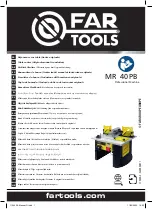
QoS Policies
7950 XRS Quality of Service Guide
Page 57
Tiers
In single tier scheduling, queues are scheduled based on the forwarding class of the queue and the
operational state of the queue relative to the queue’s CIR and PIR. Queues operating within their
CIR values are serviced before queues operating above their CIR values with “high-priority”
forwarding class queues given preference over “low-priority” forwarding class queues. In single
tier scheduling, all queues are treated as if they are at the same “level” and the queue’s parameters
and operational state directly dictate the queue’s scheduling. Single tier scheduling is the system
default scheduling policy for all the queues and destinations listed above and has no configurable
parameters.
Hierarchical scheduler policies are an alternate way to schedule queues that can be used on service
ingress and service egress queues. Hierarchical scheduler policies allow the creation of a hierarchy
of schedulers where queues and/or other schedulers are scheduled by superior schedulers.
To illustrate the difference between single tier scheduling and hierarchical scheduling policies,
consider a simple case where, on service ingress, three queues are created for gold, silver and
bronze service and are configured as follows:
•
Gold: CIR = 10 Mbps, PIR = 10 Mbps
•
Silver: CIR = 20 Mbps, PIR = 40 Mbps
•
Bronze: CIR = 0 Mbps, PIR = 100 Mbps
In the router, the CIR is used for policing of traffic (in-profile or out-of-profile), and the PIR is the
rate at which traffic is shaped out of the queue. In single tier scheduling, each queue can burst up
to its defined PIR, which means up to 150 Mbps (10 Mbps + 40 Mbps + 100 Mbps) can enter the
service.
In a simple example of a hierarchical scheduling policy, a superior (or parent) scheduler can be
created for the gold, silver and bronze queues which limits the overall rate for all queues to 100
Mbps. In this hierarchical scheduling policy, the customer can send in any combination of gold,
silver and bronze traffic conforming to the defined PIR values and not to exceed 100 Mbps.
Single Tier Scheduling
Single-tier scheduling is the default method of scheduling queues in the router. Queues are
scheduled with single-tier scheduling if no explicit hierarchical scheduler policy is defined or
applied. There are no configurable parameters for single-tier scheduling.
In single tier scheduling, queues are scheduled based on the Forwarding Class of the queue and the
operational state of the queue relative to the queue’s Committed Information Rate (CIR) and Peak
Information Rate (PIR). Queue’s operating within their CIR values are serviced before queue’s
operating above their CIR values with “high-priority” forwarding class queues given preference
over “low-priority” forwarding class queues. In Single Tier Scheduling, all queues are treated as if
Summary of Contents for 7950
Page 12: ...Page 12 7950 XRS Quality of Service Guide List of Figures ...
Page 16: ...Preface Page 16 7950 XRS Quality of Service Guide ...
Page 82: ...Editing QoS Policies Page 82 7950 XRS Quality of Service Guide ...
Page 90: ...Applying Network Queue Policies Page 90 7950 XRS Quality of Service Guide ...
Page 96: ...Editing QoS Policies Page 96 7950 XRS Quality of Service Guide ...
Page 98: ...Command Hierarchies Page 98 7950 XRS Quality of Service Guide ...
Page 108: ...Command Hierarchies Page 108 7950 XRS Quality of Service Guide ...
Page 156: ...Basic Configurations Page 156 7950 XRS Quality of Service Guide exit exit ...
Page 164: ...Queue Depth Monitoring Page 164 7950 XRS Quality of Service Guide ...
Page 304: ...Service Queue QoS Policy Commands Page 304 7950 XRS Quality of Service Guide ...
Page 368: ...Command Hierarchies Page 368 7950 XRS Quality of Service Guide ...
Page 430: ...Configuration Commands Page 430 7950 XRS Quality of Service Guide ...
Page 532: ...Editing QoS Policies Page 532 7950 XRS Quality of Service Guide ...
Page 552: ...Editing Advanced Policies Page 552 7950 XRS Quality of Service Guide ...
Page 600: ...Command Hierarchies Page 600 7950 XRS Quality of Service Guide ...
Page 602: ...QoS Commands Page 602 7950 XRS Quality of Service Guide ...
Page 610: ...Standards and Protocols Page 610 7950 XRS Quality of Service Guide ...
Page 612: ... 2015 Alcatel Lucent All rights reserved 3HE 09868 AAAA TQZZA 01 ...
















































